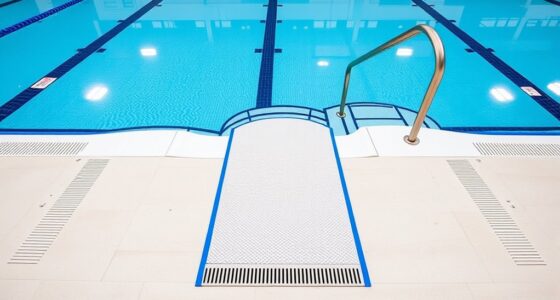To fund your municipal pool renovation, consider a mix of options like applying for government grants, seeking private foundation support, and exploring bonds or municipal budgets. You might also develop public-private partnerships with local businesses or organize fundraising events to boost community contributions. Combining these sources can maximize resources and guarantee long-term success. Keep exploring, and you’ll uncover even more strategies to help bring your project to life effectively.
Key Takeaways
- Seek grants from government agencies and private foundations dedicated to community development and environmental sustainability.
- Explore municipal bonds or allocate local government budgets for dedicated renovation funding.
- Develop public-private partnerships with local businesses or nonprofits to share costs and resources.
- Organize community fundraising events and encourage donations to supplement funding sources.
- Consider loans or financing options that support long-term operational savings and sustainability goals.

Renovating a municipal pool can enhance community health, safety, and recreation, but funding such projects often presents a challenge. One of your first steps should be to foster strong community engagement. When residents feel involved in the planning process, they’re more likely to support funding initiatives, whether through local taxes, donations, or volunteer efforts. Hosting public meetings, surveys, and workshops can gather valuable input and generate enthusiasm for the project. Community engagement also helps identify specific needs and preferences, making the renovation more tailored and effective. This sense of ownership encourages residents to advocate for the project, potentially influencing local policymakers to prioritize funding. Additionally, demonstrating how the project aligns with local regulations can help streamline approval processes and access potential funding sources.
Engage residents early to build support and tailor the pool renovation to community needs.
At the same time, you should consider the environmental impact of the renovation. Modernizing the pool to include energy-efficient systems, eco-friendly materials, and sustainable practices not only benefits the environment but can also lead to long-term cost savings. For example, upgrading to solar heating or installing filtration systems that minimize chemical use can reduce operational expenses and appeal to environmentally conscious stakeholders. Highlighting the environmental benefits during community outreach can strengthen support, especially among residents who care about sustainability. When you communicate that the renovation aligns with eco-friendly goals, you’re likely to attract grants or funding from organizations dedicated to environmental stewardship.
Exploring various funding options is vital. Traditional sources like municipal budgets or bonds often serve as starting points, but they may not cover the entire cost. Consequently, you should also consider grants from government agencies or private foundations that support recreational or environmental projects. Public-private partnerships can be another avenue, where local businesses or nonprofits contribute in exchange for recognition or future collaboration. Additionally, you might organize fundraising events or seek donations from community members and local organizations. These efforts not only help raise funds but also deepen community involvement, reinforcing the collective investment in the pool’s future.
Ultimately, the success of your renovation project hinges on balancing financial resources with community interests and environmental considerations. By engaging residents early, emphasizing sustainability, and exploring diverse funding sources, you create a strong foundation for a revitalized pool that serves the community well into the future. When residents see their input valued and understand the environmental benefits, they’re more likely to support the financial investments needed. This all-encompassing approach ensures that your municipal pool renovation is both financially feasible and aligned with broader community goals, making it a sustainable and celebrated improvement.
Frequently Asked Questions
Can Private Donations Cover Renovation Costs?
Yes, private donations can cover renovation costs if you actively engage donors and leverage private philanthropy. By fostering strong donor engagement strategies, you can attract contributions from individuals, local businesses, and foundations interested in supporting community amenities. Building relationships and showcasing the pool’s benefits encourage ongoing support, making private donations a viable funding source for your renovation project. Effective outreach and transparency are key to securing these funds.
Are There Federal Grants Specifically for Pool Upgrades?
Yes, federal grants can support pool upgrades. You should explore programs like the Community Development Block Grant (CDBG) or the EPA’s Clean Water State Revolving Fund, which often fund infrastructure projects, including municipal pool renovations. Applying for these grants involves preparing detailed proposals that highlight the project’s community benefits and environmental impact. Securing federal grants can markedly reduce your financial burden and improve your pool’s safety and sustainability.
How Long Does It Take to Secure Funding?
Securing funding can feel like waiting for a turtle to run a marathon, but it usually takes anywhere from a few months to over a year. The funding timelines depend on the grant application process, which involves detailed paperwork, reviews, and approvals. Be prepared for a potentially lengthy journey, and start early to navigate the process smoothly. Patience and persistence will turn your pool renovation dreams into reality!
What Are the Long-Term Financial Implications?
You need to take into account the long-term financial implications of pool renovations by focusing on budget planning and financial sustainability. Upfront costs may impact your budget, but ongoing expenses like maintenance and staffing can affect your financial health over time. To guarantee sustainability, develop a thorough plan that balances renovation costs with future revenue streams and operational expenses, helping you maintain the pool without straining your municipality’s budget.
Can Public-Private Partnerships Fund Renovations?
Think of public-private partnerships as bridges connecting your community’s needs to private resources. They can fund renovations by pooling public support and private investment, turning the project into a shared journey. Community engagement acts as the wind guiding the sails, ensuring everyone’s voice influences the course. Together, these partnerships create a steady current that can effectively finance pool upgrades, fostering a collaborative effort that benefits all.
Conclusion
As you explore these funding options, remember that securing support is like rallying your town’s knights for a quest. Grants, bonds, and partnerships are your trusty steeds—each with its own strengths. Don’t forget to keep your community engaged, like a town crier spreading the good news. With persistence, your pool’s renaissance will be as legendary as a Robin Hood tale, turning your vision into reality and making a splash for generations to come.








